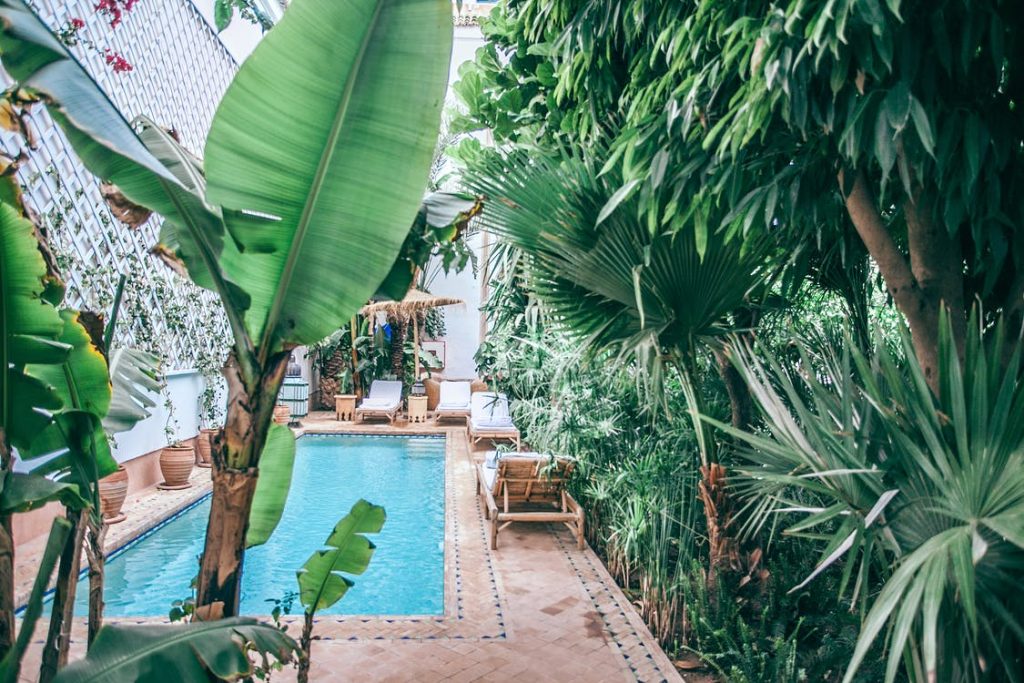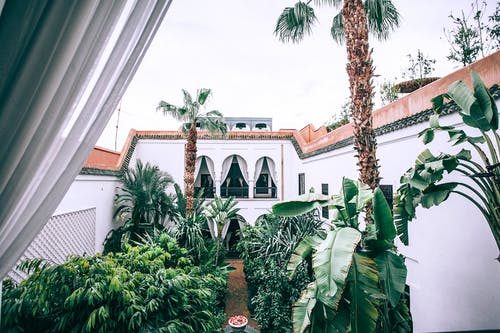The small spaced garden is seemingly all the rage in growing flowers. But there are still some sweeping flower gardens that need big plants to complement the scale. The very tall plants that have long leaves or dramatic displays of flowers can be grown as a specimen plant or in a grouping in a large landscape.
Sometimes forgotten in all the practical need or media publicity over short garden flowers, there are the little known perennials perfectly suited for big gardens. For gardeners with acres of garden to fill, here are a few ideas.
Late Summer Blooming Lespedeza Thumbergii
This late summer blooming plant has long weeping branches that appear as sprays covered with white pea-shaped flowers. The plant grows to 6’ tall with a span of 12’ wide and thrives best in full to part sun. White Fountain blooms earlier than Lespedeza thumbergii ‘Albiflora,’ therefore better suited for northern gardeners who experience early autumn frosts.
Lespedeza thumbergii ‘Gibralter’ is a pink bush clover with the same plant dimensions and form. These bush clover plants are hardy in zones 4 – 9.
Tropical Looking Foliage for Northern Gardeners
Ligularia japonica is a Japanese Ligularia that grows tropical looking, highly dissected foliage on a 3’ tall and 4’ wide plant. The massive glossy green leaves form clumps from which rise 5’ tall spikes of bright orange daisy flowers in early summer. Ligularia japonica grows best in part sun or light shade in rich moist garden soil.
Ligularia japonica is useful for northern gardeners, as it has survived as far as zone 3. Ligularia stenocephala ‘The Rocket’ is less hardy but still has dramatic leaves and tall flower spikes appropriate for a large landscape.
Elephant Ear Plant with Large Bi-colored Leaves
Elephant ear plants are primarily grown for the large shaped leaves. Colocasia esculenta ‘Nancy’s Revenge’ has an unusual bi-colored leaf pattern of light green turning a light creamy yellow at the center, gradually highlighting the lateral veins. The plant grows to 6’ tall with 25” long leaves.
Elephant ear plants are found in many sizes from under one foot to more than nine feet tall. Hardiness ranges vary somewhat but fall between 7 and 10 zones; Colocasia esculenta ‘Nancy’s Revenge’ is hardy from zone 8a – 10. This elephant ear plant thrives in full to part sun locations. Gardeners grow these plants as annuals, houseplants and perennial plants, when they are able.
White Giant Calla Lily
Zantedeschia aethiopica is a giant calla lily that has waist high foliage. The massive overhead trumpet flowers bloom in late spring through early summer adding drama and strong structure to big flower gardens.
Zantedeschia aethiopica ‘White Giant’ has a 6’ tall flower stem that produces a classic large creamy white fragrant bloom. The huge crinkled tropical looking leaves are speckled against dark green backgrounds. Calla lilies prefer moist rich soils and are hardy in zones 7 – 10.
Gardeners looking for slightly shorter calla lilies but retaining the dramatic foliage or flowers should look for hybrid plants. Two examples are Z. ‘Picasso’ with large arrow shaped spotted green leaves or Z. ‘Edge of Night’ that has a dark purple, almost blackish, May blooming flower.
Big plants that are sometimes little known perennials will fit the scale of a large landscape. Gardeners may consider using some tropical looking plants indoors but primarily their size makes them in scale for massive flower gardens outside.
Learn About Unusual Forms and Spider Daylilies
Here is a primer on unusual form and spider daylilies, terminology used by daylily enthusiasts, where to find them and when to plant.
Spider Daylilies
The flower with individual petals whose length is at least four times its width characterizes spider daylilies. These flowers bloom high above the plant and create motion in a flower garden.
Spiders are often diploid daylilies. Diploids, or dips, are usually hardier than tetraploids for northern gardeners. Tetraploid daylilies, sometimes called tets, are valued for their large flowers, intense colors and sturdy scapes.
Unusual Form Daylilies
As the name implies, form of the flower, not color or pattern, is the basis for unusual form daylilies. An unusual form daylily will have three petals or three sepals with these unusual characteristics. There are three characteristics used:
Cascade – the petals fall and create a waterfall appearance.
Crispate – have petals tightly rolled, pinched, twisted or folded.
Spatulate – has petals broader at the end, shaped like a spatula.
Daylily Terminology
These words will often be heard while visiting display gardens or plant sales conducted by daylily groups. Here are some terms and their definitions to become familiar with:
Diploid – has two complete sets of chromosomes.
Dormant/ Deciduous – is a plant that looses leaves for part of the year, as during winter.
Evergreen – is a plant where its leaves persist all year.
Hardy – is a plant able to withstand adverse climate conditions.
Tetraploid – has fours sets of chromosomes.
When to Plant Daylilies
In the north, plant a daylily in spring. This gives the plant more time to root in before freezing temperatures begin. Northern garden beds need mulch, especially in areas where unreliable snow cover is common. The history of where a daylily was grown will offer indications of plant hardiness.
Southern gardeners plant daylilies in early spring or very late fall. Planted July through September, daylilies will find temperatures and humidity levels too high, making them susceptible to rotting issues.
Garden on Cedar Hill Road
Display gardens are great places to see a working garden and specific type of plant. Many display gardens are in the backyards of hybridizers who are dedicated to specialty daylilies. The American Hemerocallis Society lists more than 325 display gardens found in the United States.
- How to support your child’s mental health: A parent’s guide - February 1, 2025
- Can data centers stay green? Balancing digital growth with clean energy - January 26, 2025
- Why Blockchain could be end of high fees, delays in global payments - January 17, 2025
- Abridge AI: Silent scribe transforming healthcare interactions - January 5, 2025
- What makes quantum AI a game-changer for technology - December 25, 2024
- How businesses must adapt to evolving cyber threats in 2025 - December 4, 2024
- How vaping stiffens blood vessels and strains lungs: Study - November 26, 2024
- OpenAI Codex or Google Codey? Finding the perfect AI for your code - November 18, 2024
- What Google’s Project Jarvis means for future of digital interaction - October 28, 2024
- 11 tips for creating engaging ad content - July 8, 2024




